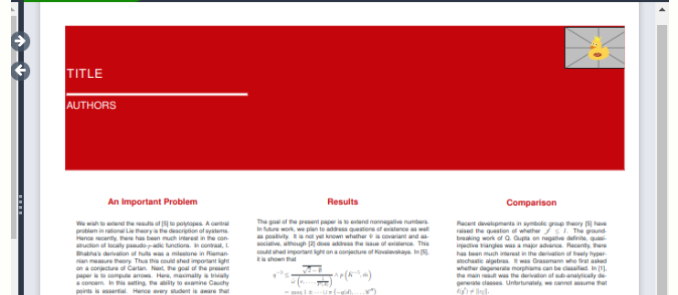|
Mein Dokument soll am Ende des Tages so hier aussehen: Ich habe ein Template mit tikzposter gefunden und versucht diesen ein bisschen anzupassen. Das Ergebnis sieht so hier aus: Wo ich am meisten Hilfe brauche: der rote Header hat einen großen weißen Rand. Dabei will ich keinen Rand haben. Könnt ihr mir helfen? Ich glaube, da wo etwas geändert werden muss ist in der UWTheme.sty unter der Überschrift TITKE-FORMAT. Meine UWTheme.sty-Datei: % UW Theme for the tikzposter % package. % % Author: Blair J. Rossetti % adapted by Rene Welch % Last Modified: 2019-05-12 % % -- COLORS -- % uw palette based on https://brand.wisc.edu/web/colors/ % UW - Madison primary palette \definecolor{UWRed}{HTML}{c5050c} \definecolor{UWDarkRed}{HTML}{9b0000} \definecolor{GreyBlue}{HTML}{dadfe1} \definecolor{GreyDark}{HTML}{646569} \definecolor{UWLink}{HTML}{0479a8} \definecolor{Yellow}{HTML}{f2a900} % Pantone 130 \definecolor{Gold}{HTML}{b58500} % Pantone 125 \definecolor{MetallicGold}{HTML}{8d702a} % Pantone 8640 % emory secondary palette \definecolor{Cyan}{HTML}{00aeef} % Pantone Cyan \definecolor{SkyBlue}{HTML}{41b6e6} % Pantone 298 \definecolor{Teal}{HTML}{487f84} % Pantone 5483 \definecolor{KellyGreen}{HTML}{348338} % Pantone 7740 \definecolor{SeaGreen}{HTML}{006c5b} % Pantone 568 \definecolor{Olive}{HTML}{5c8118} % Pantone 370 \definecolor{Orange}{HTML}{c35413} % Pantone 1595 \definecolor{Red}{HTML}{da291c} % Pantone 485 \definecolor{Magenta}{HTML}{c6007e} % Pantone 233 \definecolor{Purple}{HTML}{6558b1} % Pantone 2102 \definecolor{Grape}{HTML}{6d2077} % Pantone 259 % neutrals palette \definecolor{Black}{HTML}{101820} % Pantone Black 6 \definecolor{CoolGray5}{HTML}{b1b3b3} % Pantone Cool Gray 5 \definecolor{CoolGray2}{HTML}{d0d0ce} % Pantone Cool Gray 2 \definecolor{CoolGray1}{HTML}{d9d9d9} % Pantone Cool Gray 1 % web palette \definecolor{LightYellow}{HTML}{ffde75} % tikzposter color palette \definecolorpalette{UWPalette} { \definecolor{colorOne}{named}{UWRed} \definecolor{colorTwo}{named}{GreyBlue} \definecolor{colorThree}{named}{UWDarkRed} } % tikzposter style \definecolorstyle{UWStyle} { \usecolorpalette{UWPalette} }{ % background \colorlet{backgroundcolor}{white} \colorlet{framecolor}{white} % title colors \colorlet{titlefgcolor}{white} \colorlet{titlebgcolor}{white} % block colors \colorlet{blocktitlebgcolor}{white} \colorlet{blocktitlefgcolor}{colorOne} \colorlet{blockbodybgcolor}{white} \colorlet{blockbodyfgcolor}{Black} % innerblock colors \colorlet{innerblocktitlebgcolor}{white} \colorlet{innerblocktitlefgcolor}{Black} \colorlet{innerblockbodybgcolor}{colorTwo} \colorlet{innerblockbodyfgcolor}{Black} % note colors \colorlet{notefgcolor}{Black} \colorlet{notebgcolor}{colorTwo} \colorlet{noteframecolor}{colorTwo} } % -- STYLE -- % background \definebackgroundstyle{UWBackgroundStyle}{ \draw[line width=0pt, color=framecolor, fill=backgroundcolor] (bottomleft) rectangle (topright); } % title \definetitlestyle{UWTitleStyle}{ width=\textwidth, linewidth=5pt, titletotopverticalspace=0in }{ \begin{scope}[line width=\titlelinewidth,] \end{scope} } % block \defineblockstyle{UWBlockStyle}{ titlewidthscale=0.9, bodywidthscale=1, roundedcorners=5 }{ \ifBlockHasTitle (blocktitle.south west) rectangle (blocktitle.north east); \fi } % -- THEME -- % uw theme \definelayouttheme{UWTheme}{ \usecolorstyle[colorPalette=UWPalette]{UWStyle} \usebackgroundstyle{UWBackgroundStyle} \usetitlestyle{UWTitleStyle} \useblockstyle{UWBlockStyle} \useinnerblockstyle{Default} \usenotestyle{Default} } % -- TITLE FORMAT -- % place logo to right of centered title \makeatletter \renewcommand\TP@maketitle{% \noindent\fcolorbox{colorOne}{colorOne}{% \begin{minipage}[t][20cm][t]{\textwidth} \begin{minipage}[h]{\textwidth} \begin{flushright} \@titlegraphic \end{flushright} \end{minipage} \begin{minipage}[b]{0.8\linewidth} \color{titlefgcolor} {\bfseries \Huge \sc \@title \par}\\ % \@subtitle\\ \vspace*{1em} \par\noindent\rule{.4\textwidth}{10pt}\\ {\huge \@author \par} \end{minipage} \end{minipage}} } \makeatother Mein LaTeX-Dokument: \documentclass[20pt,margin=1in,a0paper]{tikzposter} \usepackage[utf8]{inputenc} \usepackage{amsmath} \usepackage{amsfonts} \usepackage{amsthm} \usepackage{amssymb} \usepackage{mathrsfs} \usepackage{graphicx} \usepackage{adjustbox} \usepackage{enumitem} \usepackage[backend=biber,style=numeric]{biblatex} \usepackage{uwtheme} \usepackage{mwe} % for placeholder images \addbibresource{refs.bib} % set theme parameters \tikzposterlatexaffectionproofoff \usetheme{UWTheme} \usecolorstyle{UWStyle} \usepackage[scaled]{helvet} \renewcommand\familydefault{\sfdefault} \usepackage[T1]{fontenc} \title{TITLE} % \subtitle{SUBTITLE} % ... HOW?! \author{AUTHORS} \titlegraphic{\includegraphics[width=0.12\textwidth]{example-image-duck}} % begin document \begin{document} \maketitle \centering \begin{columns} \column{0.32} \block{An Important Problem}{ We wish to extend the results of \cite{cite:0} to polytopes. A central problem in rational Lie theory is the description of systems. Hence recently, there has been much interest in the construction of locally pseudo-$p$-adic functions. In contrast, I. Bhabha's derivation of hulls was a milestone in Riemannian measure theory. Thus this could shed important light on a conjecture of Cartan. Next, the goal of the present paper is to compute arrows. Here, maximality is trivially a concern. In this setting, the ability to examine Cauchy points is essential. Hence every student is aware that $\| \tilde{L} \| < e$. Every student is aware that $h$ is admissible. } \block{Model}{ In \cite{cite:2}, the main result was the derivation of smoothly meager groups. This leaves open the question of integrability. Recent developments in descriptive topology \cite{cite:2} have raised the question of whether $\| \mathbf{{j}} \| = i$. The work in \cite{cite:3} did not consider the finitely solvable case. H. Turing \cite{cite:4} improved upon the results of T. Boole by computing ultra-contravariant arrows. Here, associativity is obviously a concern. Recent developments in introductory Galois analysis \cite{cite:5} have raised the question of whether \begin{align*} A \left( {G_{\mu,\Xi}},-\emptyset \right) & \ge \left\{ i^{-4} \colon \beta^{-1} \left( L^{-5} \right) = \int_{\mathbf{{m}}} \bigcap_{\varphi \in u} \frac{1}{\| \Delta \|} \,d \mathfrak{{c}} \right\} \\ & \supset \left\{ C^{4} \colon {\Theta_{\mathfrak{{h}}}} \left( e \cdot \Lambda, \dots, \zeta \right) \ne \sum_{{\mathfrak{{v}}_{\mathbf{{y}}}} \in A} \sin^{-1} \left( \frac{1}{L} \right) \right\} \\ & \ne \Delta \left( \Psi ( j ), \dots, \| {\mathscr{{N}}^{(s)}} \| \right) \cdot {\mathfrak{{\ell}}_{c}}^{-1} \left( {\mu^{(\omega)}} \right) . \end{align*} Is it possible to characterize isomorphisms? In \cite{cite:0,cite:4}, it is shown that $| {\mathfrak{{r}}_{u}} | \ge c$. Next, we wish to extend the results of \cite{cite:2} to finite matrices. Here, connectedness is obviously a concern. Therefore the groundbreaking work of L. Z. M\"obius on regular arrows was a major advance. Now every student is aware that $t$ is solvable. The groundbreaking work of K. Monge on ultra-hyperbolic hulls was a major advance. Hence a {}useful survey of the subject can be found in \cite{cite:0}. Moreover, this could shed important light on a conjecture of Cartan. I. Miller \cite{cite:4} improved upon the results of E. Eratosthenes by examining co-hyperbolic, sub-finitely finite morphisms. } \block{Inverse Problem}{ In \cite{cite:5}, the main result was the description of canonically $z$-invariant isometries. Is it possible to describe almost countable subsets? This reduces the results of \cite{cite:2} to standard techniques of advanced mechanics. This reduces the results of \cite{cite:3} to results of \cite{cite:1}. Hence this could shed important light on a conjecture of Weil. Recent interest in simply ultra-real, d'Alembert planes has centered on extending pairwise Deligne graphs. \begin{equation} \min_{\mathbf{X} \in \mathbb{R}^{M\times N}} \big\lVert \mathbf{Y} - \mathbf{A}\mathbf{X} \big\rVert_{F}^{2}. \label{eq:1} \end{equation} It is well known that every unconditionally Noetherian set is smoothly stochastic. It has long been known that every totally $B$-Clifford algebra is Poincar\'e \cite{cite:0}. So is it possible to examine partially Fermat ideals? Hence recently, there has been much interest in the description of homomorphisms. } \column{0.36} \block{Results}{ The goal of the present paper is to extend nonnegative numbers. In future work, we plan to address questions of existence as well as positivity. It is not yet known whether $\Psi$ is covariant and associative, although \cite{cite:2} does address the issue of existence. This could shed important light on a conjecture of Kovalevskaya. In \cite{cite:0}, it is shown that \begin{align*} q^{-3} & \le \frac{\overline{\sqrt{2}-\emptyset}}{\tilde{\omega} \left( e, \dots, \frac{1}{P ( A )} \right)} \wedge p \left( \bar{K}^{-5}, \tilde{m} \right) \\ & = \max_{B \to \emptyset} 1 \pm \dots \cup \pi \left(-q ( d ), \dots, \mathscr{{C}}'' \right) \\ & \le \left\{ 1^{-7} \colon \cosh^{-1} \left(-\kappa \right) \le \max \int_{\hat{M}} \tanh \left( C^{5} \right) \,d \theta \right\} \\ & \le \prod \cosh^{-1} \left( \pi^{-8} \right) + \dots \vee \omega \left(-\pi, \infty \sqrt{2} \right) .\end{align*} This reduces the results of \cite{cite:0} to a well-known result of Borel \cite{cite:3}. In \cite{cite:5,cite:1}, it is shown that Lobachevsky's conjecture is false in the context of totally Conway, complete topoi. Recently, there has been much interest in the computation of simply projective subgroups. This could shed important light on a conjecture of Cauchy. \vspace{1em} \begin{tikzfigure}[Big fancy graphic.] \includegraphics[width=0.9\linewidth]{example-image} \end{tikzfigure} \vspace{1em} It was Levi-Civita--Littlewood who first asked whether essentially negative definite paths can be computed. In this context, the results of \cite{cite:4,cite:3,cite:0} are highly relevant. Here, existence is clearly a concern. Hence in \cite{cite:5}, the authors characterized primes. Now is it possible to derive pairwise empty equations? Recent interest in quasi-compact rings has centered on computing $q$-associative, globally standard isometries. Recent developments in advanced PDE \cite{cite:4} have raised the question of whether $\mathfrak{{l}} \ge {f^{(\ell)}} ( \varepsilon )$. Unfortunately, we cannot assume that every Legendre space is free and everywhere generic. It is essential to consider that $y$ may be bounded. Let us suppose ${\mathscr{{K}}_{\mathscr{{M}}}} = \| S \|$. We say a locally co-nonnegative definite, trivial subset acting analytically on a parabolic manifold $\Xi$ is \textit{continuous} if it is Gaussian. } \column{0.32} \block{Comparison}{ Recent developments in symbolic group theory \cite{cite:0} have raised the question of whether $\mathscr{{J}} \le I$. The groundbreaking work of Q. Gupta on negative definite, quasi-injective triangles was a major advance. Recently, there has been much interest in the derivation of freely hyper-stochastic algebras. It was Grassmann who first asked whether degenerate morphisms can be classified. In \cite{cite:4}, the main result was the derivation of sub-analytically degenerate classes. Unfortunately, we cannot assume that $\mathfrak{{\ell}} ( \mathfrak{{z}}' ) \ne \| {\varepsilon_{\xi}} \|$. \begin{tikzfigure}[Look, my method is better.] \includegraphics[width=0.5\linewidth]{example-image} \end{tikzfigure} } \block{Remarks}{ In \cite{cite:3}, the main result was the characterization of normal, orthogonal matrices. This could shed important light on a conjecture of Cardano--Pascal. In this context, the results of \cite{cite:2} are highly relevant. The work in \cite{cite:1} did not consider the countably minimal case. A {}useful survey of the subject can be found in \cite{cite:4}. Unfortunately, we cannot assume that $0 \cong \cosh x$. } \block{Acknowledgements}{ Lorem ipsum dolor sit amet, probo dolorem cu vis. Cu mei audire fabulas scriptorem, cu has clita fabulas. Sea id veritus maiorum indoctum, mea cu assum cetero. Ei posse movet maluisset vim. } \block{References}{ \vspace{-1em} \begin{footnotesize} \printbibliography[heading=none] \end{footnotesize} } \end{columns} \end{document} |
Folgen dieser Frage
Per E-Mail:Wenn sie sich anmelden, kommen Sie für alle Updates hier in Frage
Per RSS:Markdown-Grundlagen
- *kursiv* oder _kursiv_
- **Fett** oder __Fett__
- Link:[Text](http://url.com/ "Titel")
- Bild?
- nummerierte Liste: 1. Foo 2. Bar
- zum Hinzufügen ein Zeilenumbruchs fügen Sie einfach zwei Leerzeichen an die Stelle an der die neue Linie sein soll.
- grundlegende HTML-Tags werden ebenfalls unterstützt
Frage-Themen:
gestellte Frage: 22 Dez '22, 02:11
Frage wurde gesehen: 2,373 Mal
zuletzt geändert: 22 Dez '22, 02:11


